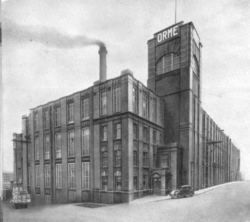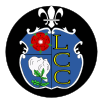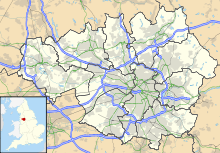- Orme Mill, Waterhead
-
Coordinates: 53°32′53″N 2°04′26″W / 53.5481°N -2.0738°E
Orme 
Cotton Spinning (ring mill) Location Waterhead Oldham Further ownership Lancashire Cotton Corporation (1930s) Courtaulds (1964) Coordinates 53°32′53″N 2°04′26″W / 53.5481°N -2.0738°E Construction Built 1908 Demolished 1960 Floor count 4 Floor area 29493 sq ft, 9425 sq m Power Date 1911 Construction Firm George Saxon Engine Type vertical triple expansion engine Valve Gear Corliss valves on all cylinders rpm 75rpm Diameter of Flywheel 22ft Type of transmission ropes No, of Ropes. 35 Boiler configuration Pressure 180psi Cotton count medium References [1] [2] Orme Mill, Waterhead is a cotton spinning mill in Waterhead, Oldham, Greater Manchester. It was built in 1910. It was taken over by the Lancashire Cotton Corporation in the 1930s and production finished in 1960. The mill was passed on to Ferranti in 1964, and is now in multiple usage.
Contents
Location
Oldham is a large town in Greater Manchester, England.[3] It lies amongst the Pennines on elevated ground between the rivers Irk and Medlock, 5.3 miles (8.5 km) south-southeast of Rochdale, and 6.9 miles (11.1 km) northeast of the city of Manchester. Oldham is surrounded by several smaller settlements which together form the Metropolitan Borough of Oldham; Lees and Waterhead are such settlements to the east of the town centred. Waterhead lies on high ground on the Huddersfield to the Manchester road. A rail service was provided by the Oldham Loop Line that was built by the Lancashire and Yorkshire Railway. Waterhead hosted a group of twentieth century mill: Orme, Majestic, Cairo, Bangor, Oldham and Lees and the older Hey Mill.
History
Oldham rose to prominence during the 19th century as an international centre of textile manufacture. It was a boomtown of the Industrial Revolution, and amongst the first ever industrialised towns, rapidly becoming "one of the most important centres of cotton and textile industries in England"[4], spinning Oldham counts, the coarser counts of cotton. Oldham's soils were too thin and poor to sustain crop growing, and so for decades prior to industrialisation the area was used for grazing sheep, which provided the raw material for a local woollen weaving trade.[5] It was not until the last quarter of the 18th century that Oldham changed from being a cottage industry township producing woollen garments via domestic manual labour, to a sprawling industrial metropolis of textile factories.[5] The first mill, Lees Hall, was built by William Clegg in about 1778. Within a year, 11 other mills had been constructed,[6] but by 1818 there were only 19 of these privately owned mills.[7]
It was in the second half of the 19th century, that Oldham became the world centre for spinning cotton yarn.[7]. This was due in a large part to the formation of limited liability companies known as Oldham Limiteds. In 1851, over 30% of Oldham's population was employed within the textile sector, compared to 5% across Great Britain.[8] At its zenith, it was the most productive cotton spinning mill town in the world.[9][10]. By 1871 Oldham had more spindles than any country in the world except the United States, and in 1909, was spinning more cotton than France and Germany combined.[11] By 1911 there were 16.4 million spindles in Oldham, compared with a total of 58 million in the United Kingdom and 143.5 million in the world; in 1928, with the construction of the UK's largest textile factory Oldham reached its manufacturing zenith.[7] At its peak, there were over 360 mills, operating night and day;[12][13]
The industry peaked in 1912 when it produced 8 billion yards of cloth. The Great War of 1914–1918 halted the supply of raw cotton, and the British government encouraged its colonys to build mills to spin and weave cotton. The war over, Lancashire never regained its markets. The independent mills were struggling. The Bank of England set up the Lancashire Cotton Corporation in 1929 to attempt to rationalise and save the industry.[14] Orme Mill, Waterhead was one of 104 mills bought by the LCC, and one of the 53 mills that survived until 1950. Post cotton, Orme Mill hosted a Ferranti ITEC centre [2], and is now in multiple usage including a firm of architects.
Architecture
Four floors from 29493 sq ft, 9425 sq m (103,820 sq ft) in total.
Power
It was powered by a 1250 hp, vertical triple expansion engine by George Saxon & Co of Openshaw, in 1911. The cylinders, 21"HP, 33"IP, 51"LP had a 4 ft (1.2 m) stroke. These operated 35 ropes from a 75rpm 22 ft (6.7 m) flywheel. They were steamed at 180psi.[15] The engine weighed 22 tons.[2]
Equipment
62,000 ring spindles by T. Holt, and Tweedale & Smalley.
Later extensions
Usage
Owners
- Lancashire Cotton Corporation (1930s–1960)
- Ferranti
Tenants
Notable events/media
See also
Lancashire cotton Architects 
Engine makers Daniel Adamson · Ashton Frost · Ashworth & Parker · Bateman & Sherratt · Boulton & Watt · Browett & Lindley · Buckley & Taylor · Carel · Earnshaw & Holt · Goodfellow · Fairbairn · W & J Galloway & Sons · B Goodfellow · Hick, Hargreaves & Co · Benjamin Hick and Sons · John Musgrave & Sons · J & W McNaught · Petrie of Rochdale · George Saxon · Scott & Hodgson · Urmson & Thompson · Yates of Blackburn · Yates & Thom · Whilans · J & E Wood · Woolstenhulmes & RyeMachinery makers Brooks & Doxey · Butterworth & Dickinson · Curtis, Parr & Walton · Dobson & Barlow · John Hetherington & Sons · Joseph Hibbert · Howard & Bullough · Geo. Hattersley · Asa Lees · Mather & Platt · Parr, Curtis & Madely · Platt Brothers · Taylor, Lang & Co · Textile Machinery Makers Ltd · Tweedales & Smalley- Oldham Limiteds · Fine Spinners and Doublers · Lancashire Cotton Corporation · Courtaulds · Bagley & WrightIndustrial processes Textile manufacturing · Cotton-spinning machinery · Friction Spinning · Magnetic ring spinning · Open end spinning · Ring spinning · Spinning frame · Spinning jenny · Spinning mule · Water frame · Roberts Loom · Lancashire LoomLists of mills LCC mills · Bolton · Bury · Cheshire · Derbyshire · Lancashire · Manchester · Oldham · Rochdale · Salford · Stockport · Tameside · WiganMuseums Bury Pilot Mill, Bury · Wilton Mill, Radcliffe
Bolton Lancashire Manchester and Salford Oldham Ace Mill, Hollinwood · Blackridings Mill, Oldham · Dawn Mill, Shaw · Fox Mill, Hollinwood · Hawk Mill, Shaw · Heron Mill, Hollinwood · Junction Mill, Middleton Junction · Kent Mill, Chadderton · Laurel Mill, Middleton Junction · Magnet Mill, Chadderton · Majestic Mill, Waterhead · Manor Mill, Chadderton · Newby Mill, Shaw · Orme Mill, Waterhead · Regent Mill, Failsworth · Royd Mill, Oldham · Royton Ring Mill, Royton · Rutland Mill, Shaw · Textile Mill, Chadderton · Trent Mill, ShawRochdale Stockport Elder Mill, Romiley · Kingston Mill, Stockport · Palmer Mills, Stockport · Vernon Mill, Stockport · Welkin Mill, Lower BredburyTameside Atlas Mill, Ashton-under-Lyne · Cedar Mill, Ashton-under-Lyne · Rock Mill, Ashton-under-Lyne · Saxon Mill, Droylsden · Stalybridge Mill, Stalybridge · Texas Mill, Ashton-under-Lyne · Tudor Mill, Ashton-under-Lyne · Waterside Mill, Ashton-under-LyneWigan West Yorkshire References
- ^ LCC 1951
- ^ a b c Gurr & Hunt 1985, p. 83.
- ^ Greater Manchester Gazetteer, Greater Manchester County Record Office, Places names – O to R, http://www.gmcro.co.uk/Guides/Gazeteer/gazzo2r.htm, retrieved 9 July 2007
- ^ Oldham County Borough Council (1973), Official Handbook of Oldham
- ^ a b Butterworth, Edwin (1981), Historical Sketches of Oldham, E.J. Morten, ISBN 978-0-85972-048-9
- ^ Bateson, Hartley (1949), A Centenary History of Oldham, Oldham County Borough Council, ISBN 5-00-095162-X
- ^ a b c . McNeil, R.; Nevell, M. (2000), A Guide to the Industrial Archaeology of Greater Manchester, Association for Industrial Archaeology, ISBN 0-9528930-3-7
- ^ Foster, John (1974), Class Struggle and the Industrial Revolution – Early industrial capitalism in three English towns, Weidenfield & Nicolson, ISBN 978-0-297-76681-0
- ^ Gurr & Hunt 1998, pp. 1–5
- ^ NW Cotton Towns Learning Journey, spinningtheweb.org.uk, http://www.spinningtheweb.org.uk/journey.php?Title=NW+Cotton+towns+learning+journey&step=2&theme=places, retrieved 2007-09-14
- ^ Oldham Metropolitan Borough Council (2001) (PDF), Contaminated Land Strategy 2001, oldham.gov.uk, p. 16, http://www.oldham.gov.uk/contaminatedlandstrategy.pdf, retrieved 2008-03-11
- ^ Visit Oldham – The History of Oldham, visitoldham.co.uk, archived from the original on 2007-08-06, http://web.archive.org/web/20070806150248/http://www.visitoldham.co.uk/heritage/history.htm, retrieved 2007-09-16
- ^ Spinning The Web – Oldham, spinningtheweb.org.uk, http://www.spinningtheweb.org.uk/m_display.php?irn=52&sub=nwcotton&theme=places&crumb=Oldham, retrieved 2006-06-28
- ^ Dunkerley 2009
- ^ Roberts 1921
Notes
Bibliography
- Dunkerley, Philip (2009). "Dunkerley-Tuson Family Website, The Regent Cotton Mill, Failsworth". http://dunkerley-tuson.co.uk/regentmill.aspx. Retrieved 2009-01-09.
- LCC (1951). The mills and organisation of the Lancashire Cotton Corporation Limited. Blackfriars House, Manchester: Lancashire Cotton Corporation Limited.
- Gurr, Duncan; Hunt, Julian (1985), The Cotton Mills of Oldham, Oldham Education & Leisure, ISBN 0-902809-46-6
- Roberts, A S (1921), "Arthur Robert's Engine List", Arthur Roberts Black Book. (One guy from Barlick-Book Transcription), http://oneguyfrombarlick.co.uk/forum_topic.asp?TOPIC_ID=7926&FORUM_ID=99&CAT_ID=3&Forum_Title=Rare+Text+(Book+Transcriptions)&Topic_Title=ARTHUR+ROBERTS+ENGINE+LIST&whichpage=1&tmp=1#pid81483, retrieved 2009-01-11
External links
Categories:- Textile mills owned by the Lancashire Cotton Corporation
- Textile mills in Oldham
- Waterhead, Greater Manchester
Wikimedia Foundation. 2010.

